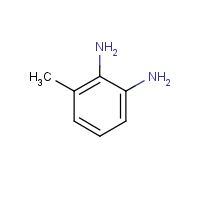2,3-Diaminotoluene
Agent Name
2,3-Diaminotoluene
CAS Number
2687-25-4
Formula
C7-H10-N2
Major Category
Nitrogen Compounds

Synonyms
1,2-Benzenediamine, 3-methyl-; 1,2-Diamino-3-methylbenzene; 1-Methyl-2,3-phenylenediamine; 2,3-Toluylenediamine; 2,3-Tolylenediamine; 3-Methyl-1,2-benzenediamine; 3-Methyl-1,2-phenylenediamine; 3-Methyl-o-phenylenediamine; Toluene, 2,3-diamino-; Toluene-2,3-diamine; [ChemIDplus] 2,3-TDA; [OECD SIDS]
Category
Amines, Aromatic
Description
Solid; [HSDB] Brown powder; [MSDSonline]
Sources/Uses
Used as a chemical intermediate for tolyltriazole (corrosion inhibitor); Manufactured by two US companies as 65:35 mixture of 3,4- and 2,3-diaminotoluenes; Also found as minor impurity in production of other diaminotoluene isomers; [HSDB] Only commercially available as 40:60 mixture of the ortho (2,3- and 3,4) isomers used as co-reactants or raw materials in the production of dyes, corrosion inhibitors, urethane products, and rubber antioxidants; Also used to lesser extent to make mercaptotoluimidazole and its zinc salt (specialty antioxidants in nitrile rubber elastomers) and as substitute for o-phenylenediamine in epoxy resin curing, polymer initiating, cross-linking, chain extending, and capping; The commercial mixture may be represented by CAS #'s 25376-45-8 and 26966-75-6 (although these CAS #’s may also be used for other isomeric mixtures); [OECD SIDS]
Comments
External application to rabbit eyes scored 7 on a scale of 1-10 (10 being most severe) for degree of injury (2,3/3,4 mixture); Emergency treatment: Methemoglobinemia; [HSDB] Commercial mixture (2,3/3,4-TDA[40/60]): Oral LD50 (rat) = 660 mg/kg; Dermal LD50 (rabbit) => 5750 mg/kg; A mild skin and eye irritant; Toxic to reproduction and development, likely to be genotoxic, and possesses carcinogenic potential; [OECD SIDS] Ortho-TDA (mixture of 3,4 [50%], 2,3 [45%], and 2,4 [1%] TDA isomers): Causes male reproductive toxicity (decreased body weights and number of spermatids/g testes) and couple/developmental toxicity (decreased number of implantation sites and delivered pups and increased post-implantation loss and pup mortality) in gavage study of rats at 250 mg/kg/day; [EPA TSCA] See "2,4-Diaminotoluene."
Biomedical References
Exposure Assessment
Vapor Pressure
0.000553 mm Hg
Adverse Effects
Skin Sensitizer
Yes
Methemoglobinemia
MetHgb is secondary toxic effect
Hepatotoxin
Hepatoxic (a) from occupational exposure (secondary effect) or (b) in animal studies or in humans after ingestion
Reproductive Toxin
Yes
Diseases, Processes, and Activities Linked to This Agent
Diseases
Occupational diseases associated with exposure to this agent: